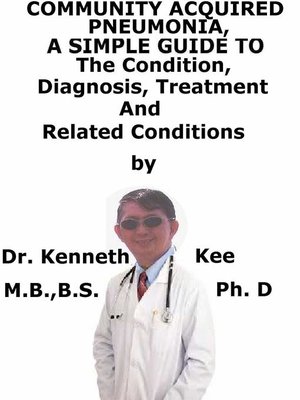Community Acquired Pneumonia, a Simple Guide to the Condition, Diagnosis, Treatment and Related Conditions
ebook
By Kenneth Kee

Sign up to save your library
With an OverDrive account, you can save your favorite libraries for at-a-glance information about availability. Find out more about OverDrive accounts.
Find this title in Libby, the library reading app by OverDrive.



Search for a digital library with this title
Title found at these libraries:
| Loading... |
This book describes Community Acquired Pneumonia, Diagnosis and Treatment and Related Diseases
Community-acquired pneumonia (CAP) is one of the most frequent infectious diseases and is an important cause of disease and death worldwide.
Numerous other micro-organisms can produce CAP in the proper medical situation.
Epidemiologic data may provide indications to the specific organism causing CAP such as:
1. The most frequent bacterial pathogen generally is S pneumoniae, even though, in some situations, including in the USA, its incidence is reducing, possibly due to vaccination.
2. Underlying chronic obstructive pulmonary disease (COPD: H influenzae or M catarrhalis
3. Recent influenza infection: Staphylococcus aureus or S pneumoniae
4. Alcoholic patient manifesting with "currant jelly" sputum: Klebsiella pneumoniae
Also, the atypical CAP pathogens are really frequent sources of CAP and were initially classified as atypical since they are not easily detectable on Gram stain or cultivated on bacteriologic media.
CAP is normally obtained by inhalation or aspiration of a pathogenic organism.
Aspiration pneumonia is often induced by multiple micro-organisms (e.g., aerobic/anaerobic oral organisms).
Typical community-acquired pneumonia
Typical bacterial pathogens that cause CAP are:
1. Streptococcus pneumoniae,
2. Haemophilus influenzae, and
3. Moraxella catarrhalis.
With the introduction of novel diagnostic methods, viral respiratory pathogens are more often being identified as frequent causes of CAP.
The most frequent viral micro-organisms obtained from hospitalized patients with CAP are:
1. Human rhinovirus and
2. Influenza.
Atypical community-acquired pneumonia
The medical manifestation of "atypical" CAP is often sub-acute and often gradual.
Also, patients with atypical CAP may present with more subtle pulmonary signs, non-lobar infiltrates on radiography, and numerous extra-pulmonary presentations (e.g., diarrhea, otalgia).
Atypical CAP pathogens are:
1. Mycoplasma pneumoniae
2. Chlamydophila ( Chlamydia) pneumoniae
3. Legionella pneumophila (Legionnaires disease)
4. Respiratory viruses such as:
a. Influenza A and B
b. Rhinovirus
c. Respiratory syncytial virus
d. Human metapneumovirus
e. Adenovirus 4 and 7
f. Parainfluenza virus
Other rare CAP pathogens are:
1. Viruses
a. Coxsackievirus
b. Echovirus
c. Coronavirus (MERS-CoV, SARS)
d. Hantavirus
e. Epstein-Barr virus
f. Cytomegalovirus
g. Herpes simplex virus
h. Human herpesvirus 6
i. Varicella-zoster virus
j. Metapneumovirus
2. Bacteria
a. Chlamydophila psittaci (psittacosis)
b. Coxiella burnetii (Q fever)
c. Francisella tularensis (tularemia)
d. Mycobacteria
e. Mycobacteria tuberculosis
f. Non-tuberculous mycobacteria (uncommon)
3. Endemic fungi
a. Histoplasma capsulatum
b. Cryptococcus neoformans and neoformans gattii
c. Coccidioides immitis
The most frequent symptoms of CAP are:
a. Cough that may bring up green, yellow, or bloody mucus
b. Fever, which may be mild or high with chills, or severe shaking
c. Shortness of breath
d. Breathing and heartbeat that is faster than usual
e. Sharp or stabbing chest pain that gets worse when the patient breathes in or cough
f. Fatigue and loss of appetite
g. Trouble thinking clearly
h. Excess sweating and clammy skin
i. Headache
j. Loss of appetite, low energy, and fatigue
k. Malaise
l. White nail syndrome, or...






